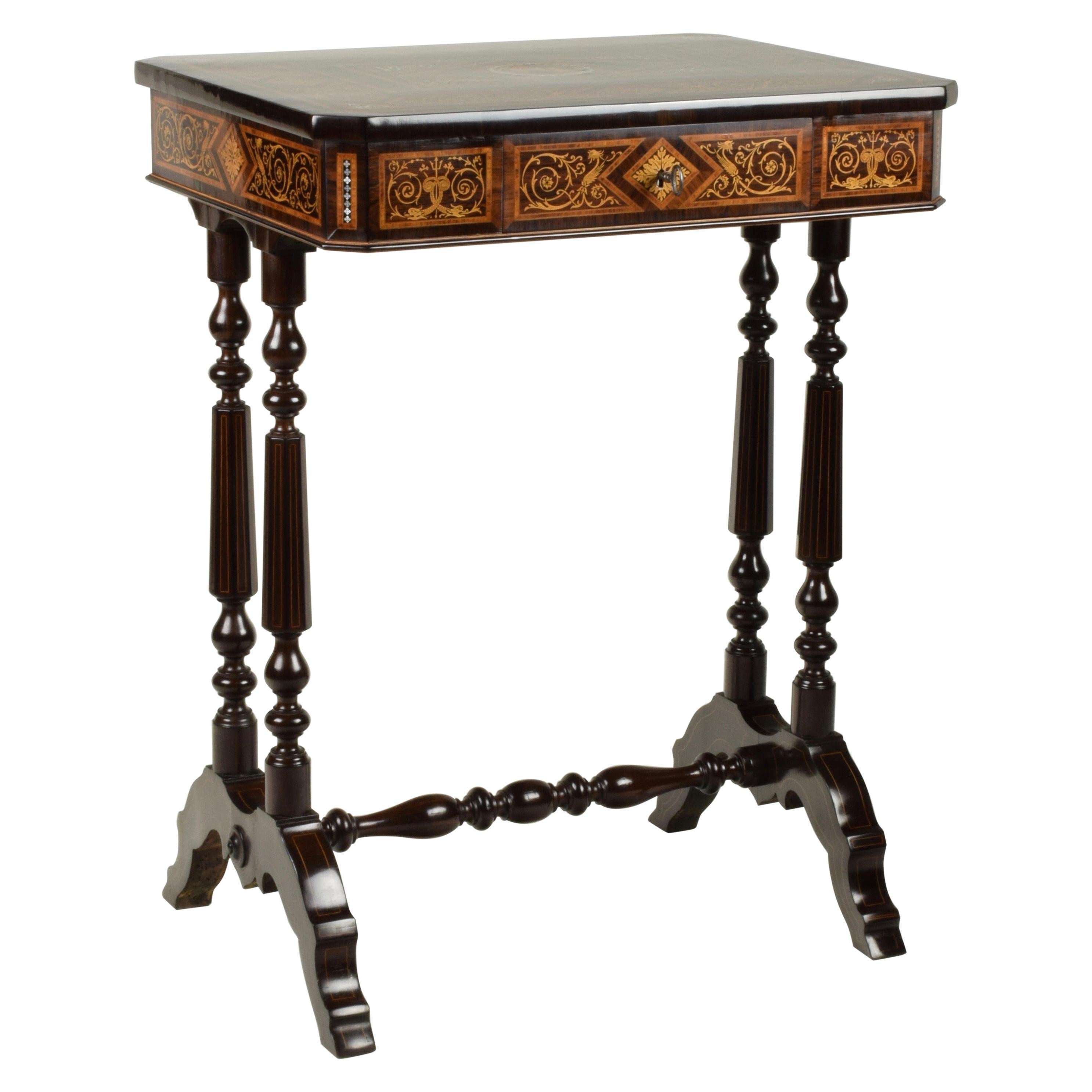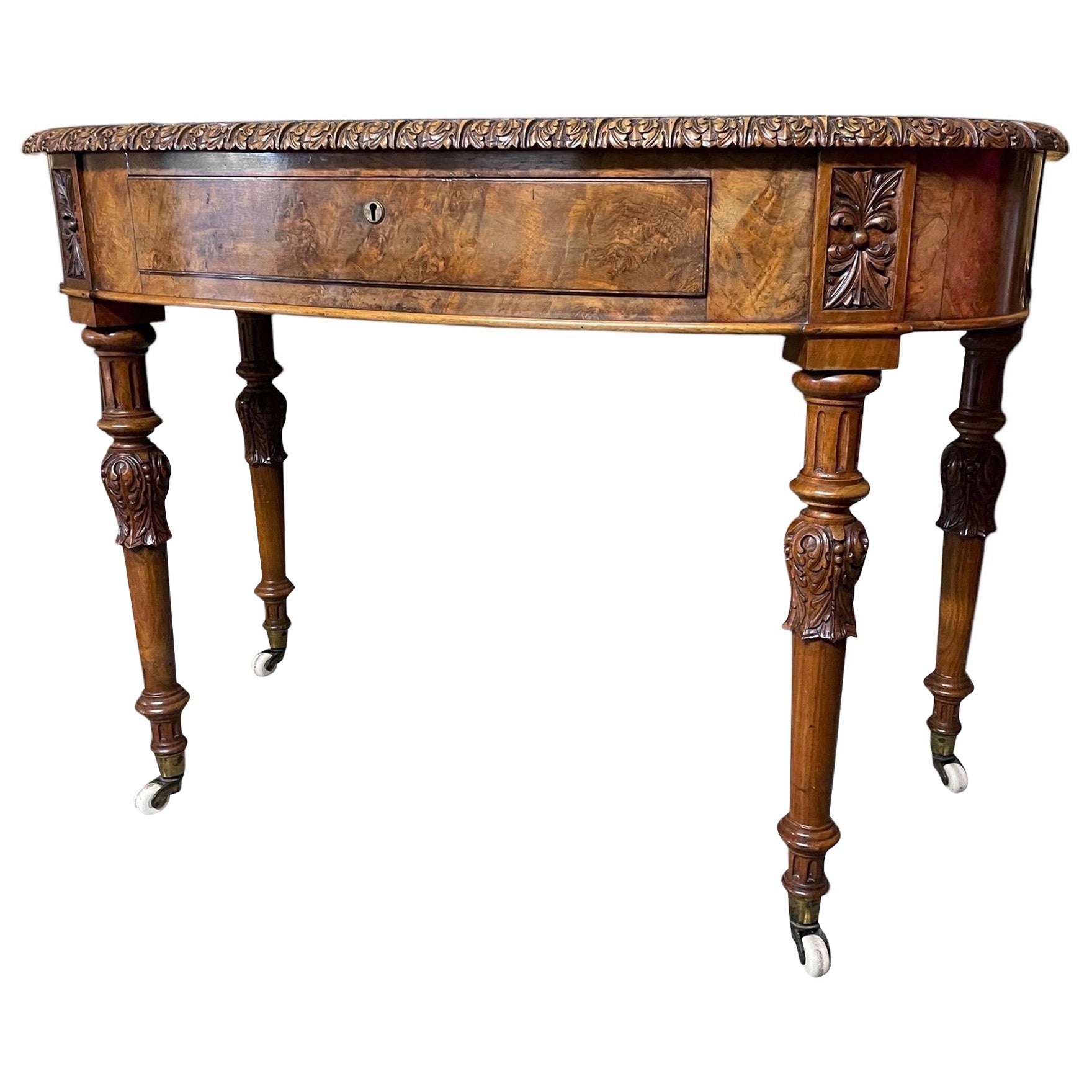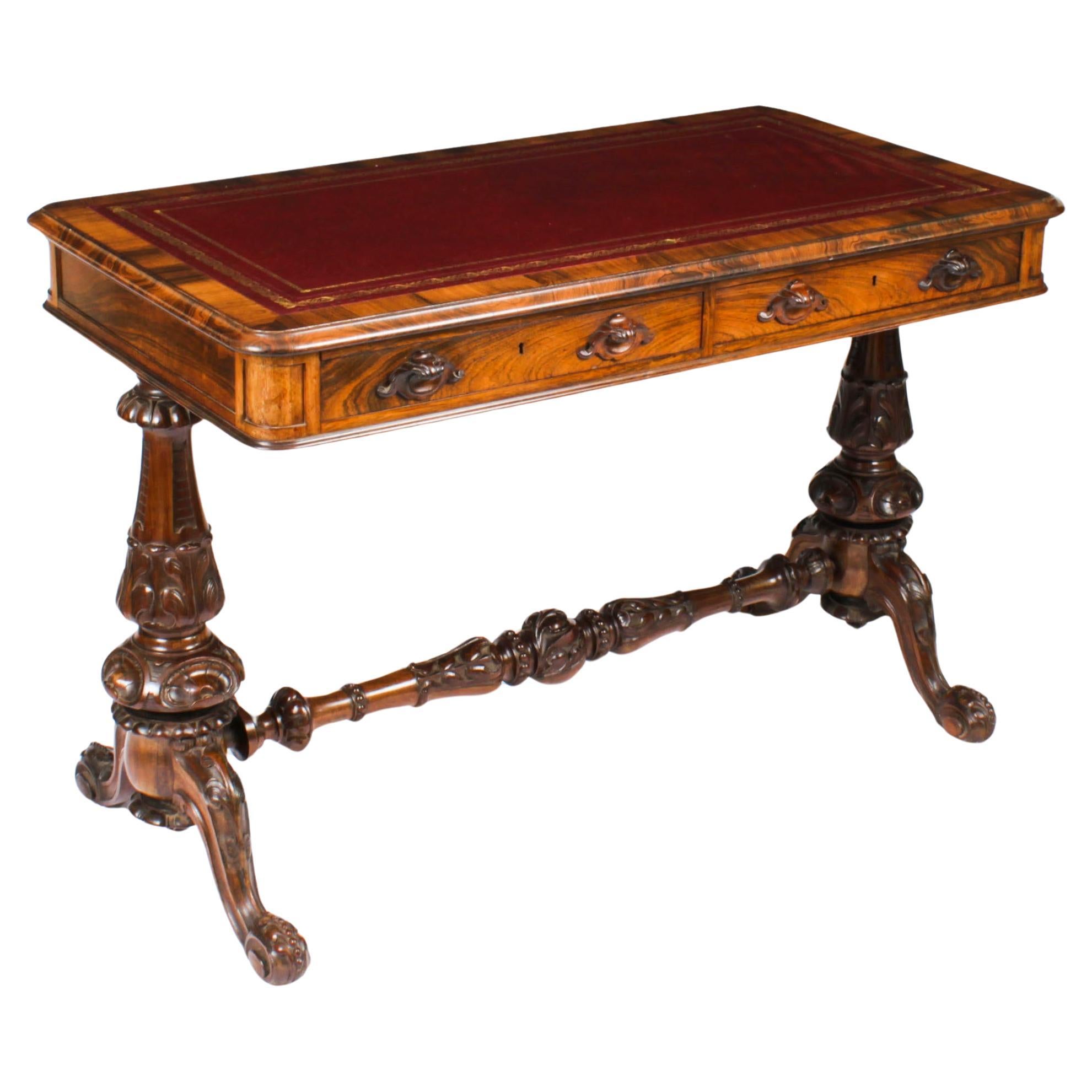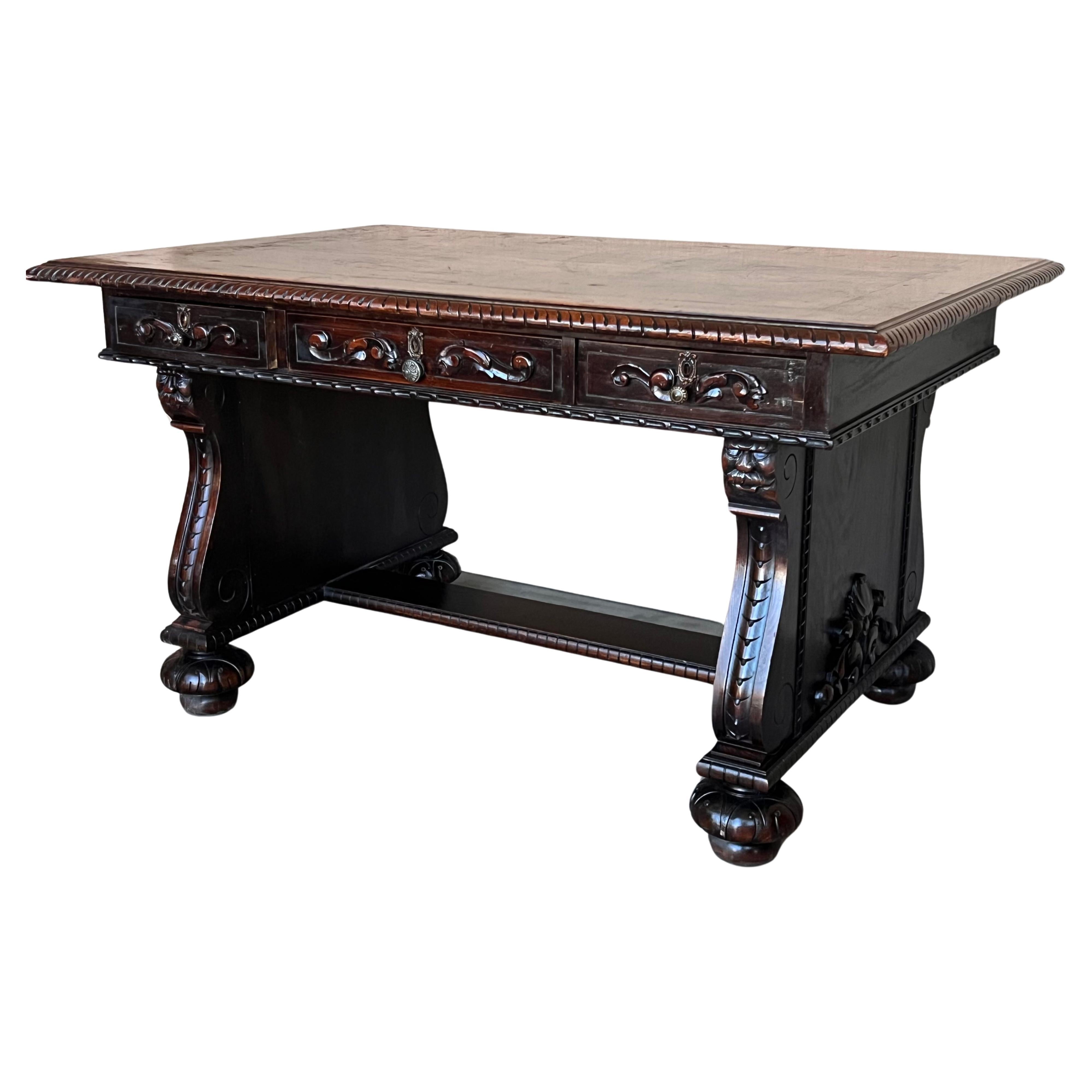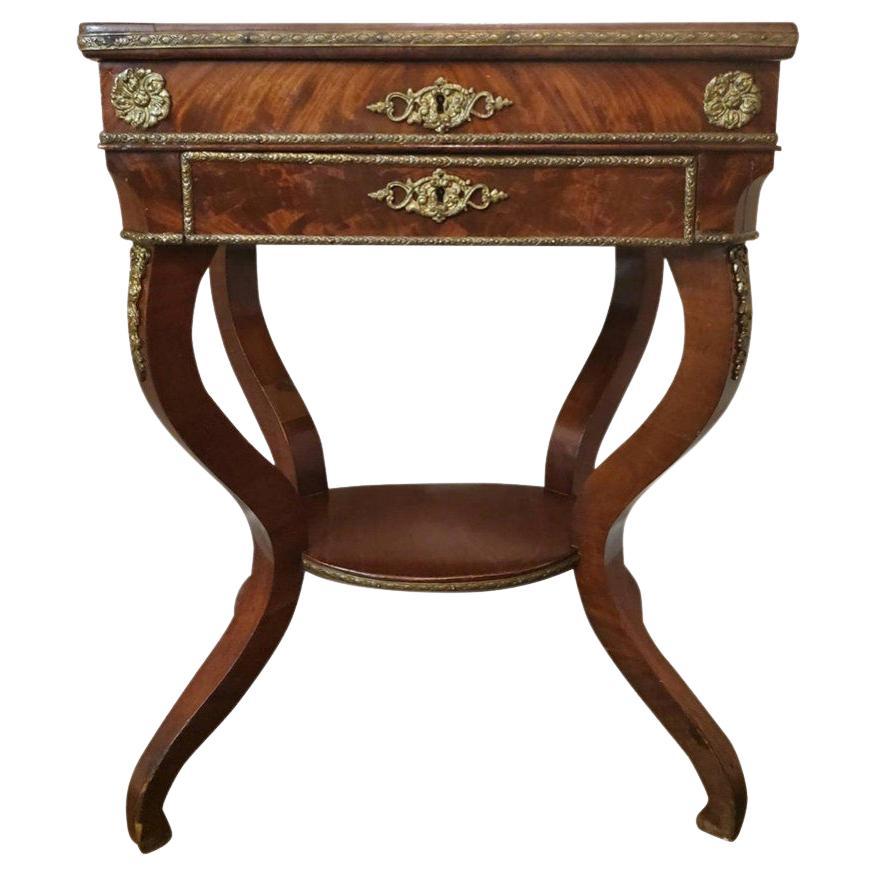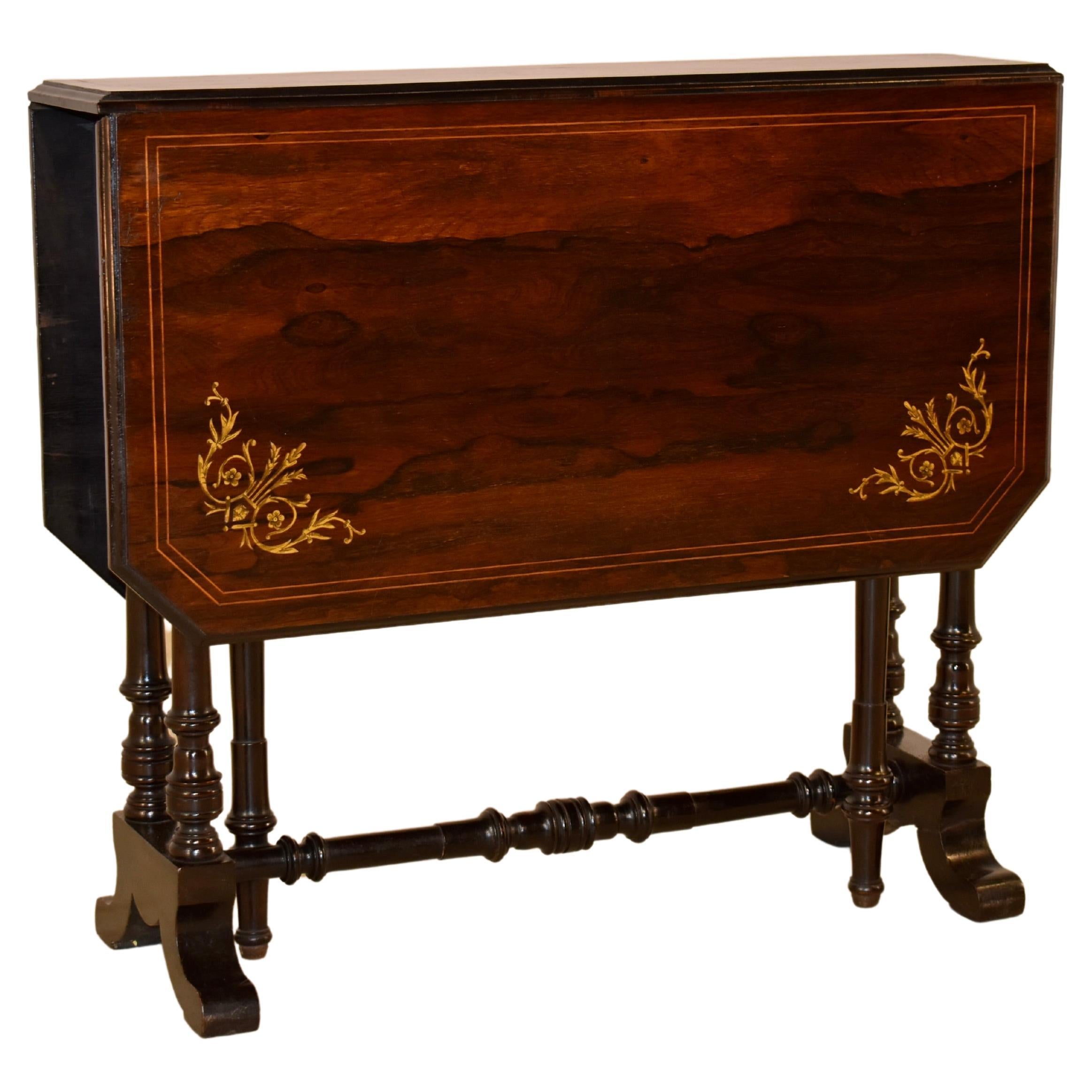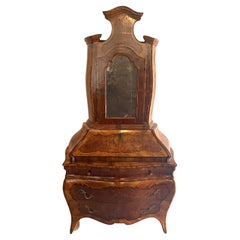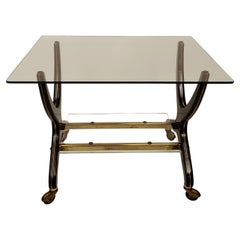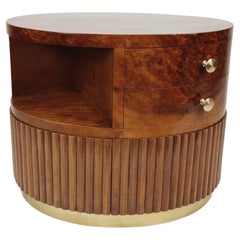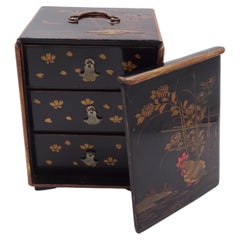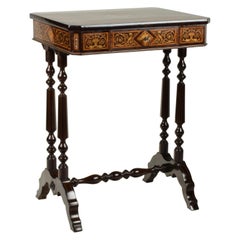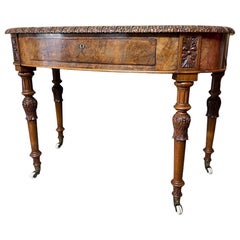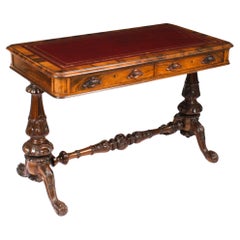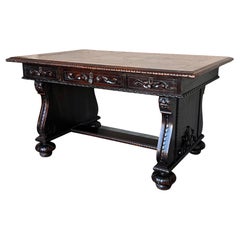Items Similar to English Openable Work Table, 19th Century
Video Loading
Want more images or videos?
Request additional images or videos from the seller
1 of 17
English Openable Work Table, 19th Century
$1,053.51
$1,915.4844% Off
£787.85
£1,432.4544% Off
€880
€1,60044% Off
CA$1,451.69
CA$2,639.4344% Off
A$1,583.75
A$2,879.5544% Off
CHF 838.59
CHF 1,524.7144% Off
MX$18,977.89
MX$34,505.2644% Off
NOK 10,679.89
NOK 19,417.9844% Off
SEK 9,765.97
SEK 17,756.3044% Off
DKK 6,702.24
DKK 12,185.9044% Off
About the Item
Small work table with opening top made of ebonized oak with inlaid details. On the top is a graceful geometric decoration containing within it a medallion painted with floral motifs, while the different sides also have decorations with naturalistic motifs.
The cabinet is of English origin, dating from around the second half of the 19th century it has recently undergone light restoration.
- Dimensions:Height: 29.93 in (76 cm)Width: 18.12 in (46 cm)Depth: 14.18 in (36 cm)
- Style:Victorian (Of the Period)
- Materials and Techniques:
- Period:
- Date of Manufacture:Mid-1800s
- Condition:Refinished.
- Seller Location:Vicenza, IT
- Reference Number:1stDibs: LU6676231166122
About the Seller
5.0
Vetted Professional Seller
Every seller passes strict standards for authenticity and reliability
Established in 1990
1stDibs seller since 2022
12 sales on 1stDibs
Typical response time: 1 hour
- ShippingRetrieving quote...Shipping from: Vicenza, Italy
- Return Policy
More From This Seller
View AllTrumeau Mid-19th Century, Northern Italy
Located in Vicenza, VI
Trumeau datable to about 1860, from northern Italy.
The cabinet in question is entirely veneered in walnut and burl walnut, filleted in Fine woods, with a fir back and interior. T...
Category
Antique 1860s Italian Rococo Credenzas
Materials
Wood, Walnut
$4,788 Sale Price
50% Off
Wood, glass and brass trolley in Art Deco style - 1950s, Italy
Located in Vicenza, VI
A cart dating from about the 1950s measuring 48x60x42 cm.
The frame features curved wooden legs with a dark finish, embellished with gold details. The top and bottom surfaces are ma...
Category
Vintage 1950s Italian Art Deco Carts and Bar Carts
Materials
Brass
$670 Sale Price
41% Off
Oval center table, Italian manufacture, c. 1930/40. Art Decò
Located in Vicenza, VI
Oval-shaped center table with two drawers and a door, made in Italy in the 1930s7'40s in the Art Deco style. The frame is veneered (or panelled) in walnut and burl walnut, while the ...
Category
Vintage 1930s Italian Art Deco Center Tables
Materials
Brass
Three-drawer box of Chinese scope, late 19th century with floral decoration
Located in Vicenza, VI
hree-drawer box with closing panel of Chinese ambit, datable to the late 1800s.
The box is made of lacquered wood, on all sides there are plant and floral decorations, having as sub...
Category
Antique Late 19th Century Chinese Chinese Export Antiquities
Materials
Wood, Lacquer
$766 Sale Price
61% Off
Poltrona in legno di noce del XIX secolo di epoca Biedermeier
By Biedermeier
Located in Vicenza, VI
Poltrona Biedermeier in legno di noce, di ambito veneto eseguita nella prima metà del XIX secolo, 1820 circa.
La poltrona misura cm 95,5x59x56 ed è in buono stato di conservazione. P...
Category
Antique 19th Century Italian Biedermeier Armchairs
Materials
Wood, Walnut
$861 Sale Price
37% Off
Cronometro da marina, SEWILL, Inghilterra fine XIX secolo
By Sewill & Liverpool
Located in Vicenza, VI
Cronometro da marina prodotto da Sewill, custodito in una cassa cubica in legno di palissandro, con spigoli e filettature in ottone, di dimensioni 18x18x19 cm. È dotato di due coperc...
Category
Antique Late 19th Century English Other Nautical Objects
Materials
Brass
You May Also Like
Work Table, Florentine Cabinetry, circa 1850
By Fratelli Falcini
Located in Prato, IT
This table is characterized by the high quality of the decoration, a dense but orderly inlay, evident in the absolute precision in cutting and combination of the various materials (p...
Category
Antique Mid-19th Century Italian Other Tables
Materials
Mother-of-Pearl, Boxwood, Cherry, Ebony, Maple, Palisander, Rosewood
19th Century English Writing Reading Table
Located in Cranbrook, Kent
Mid 19th Century writing table in flame cut walnut with leather writing pad top
revealing a built in adjustable slope.
Circa 1860 this represents one of the finest examples of cabine...
Category
Antique Mid-19th Century British Early Victorian Desks and Writing Tables
Materials
Walnut
Antique Victorian Writing Table Desk by Edwards & Roberts 19th Century
Located in London, GB
This is an elegant antique Victorian Gonçalo Alves writing table by Edwards & Roberts, Circa 1850 in date.
The top is inset with a gold tooled burgundy leather writing surface abo...
Category
Antique 1850s Desks and Writing Tables
Materials
Leather, Wood
19th Century French Renaissance Desk with Three drawers
Located in Miami, FL
19th Century French Renaissance desk with dolphins is a remarkably sculpted work with fully carved apron all around, making it a great choice for placement in the center of the room ...
Category
Antique Late 19th Century French Renaissance Desks and Writing Tables
Materials
Walnut
19th C. French Charles X Restoration Period Sewing Stand Work Table
Located in Forney, TX
A scarce period Charles X (1818-1834) French Restoration mahogany travailleuse sewing (thread stand - side table - jewelry dressing table) with light, warm, beautifully aged patina.
Born in France in the early 19th century, almost certainly Parisian work, exquisitely hand-crafted, this exceptionally executed example features ornate gilt bronze ormolu mounts, escutcheons, and elaborate gilt metal trim. Having a highly figured light mahogany hinged lid top, lifting open to reveal a striking finished interior with divided compartments and original inset mirror plate. The conforming rectangular case fitted with a faux drawer front over a dovetailed drawer with sectioned interior. Elegantly rising on oval-shaped medial shelf stretcher-joined curvacious legs.
Dimensions (approx):
27" High, 20" Wide, 13.5" Deep
Stunning light almost blonde antique mahogany coloring and mellow warm tone, superb wood grain detail, and charming, beautifully aged patina over the whole. Great shape overall. Retaining original antique character marks, wear consistent with age and indicative of minimal use, nothing that detracts from the aesthetics or functionality, but only adds to the overall authenticity, refined elegant warmth, luxurious sophistication, and cozy unpretentious rustic elegance.
Delivered cleaned, hand waxed, polished French patina finish, ready for immediate use and generational enjoyment!
What is Charles X style:
The comte d’Artois – or Charles X - was the son of the dauphin Louis-Ferdinand de Franc and Marie-Josèphe de Saxe. He succeeded his two brothers Louis XVI and Louis XVIII and became the King of France in 1824. Thirty years after the French Revolution, he wanted to embody the return of monarchy and became the leader of the catholic party . As the previous kings, he was crowned in 1825 but he was soon overthrown by the revolution in July, 1830, called "Trois Glorieuses". He left then for England, Scotland, Prague and Istria where he died in 1836.
Charles X style lasted from 1818 to 1834 and happened during the Bourbon Restoration (French Restoration). This style did not replace totally the style of furniture from the French Empire but it was different from the formalism in the Napoleonic era, during which strictness and simplicity were inspired by Greco-Roman art. Indeed, artistic fields flourished. In terms of furniture, this renewal was suggested by the softening of shapes. Even though the simple aspect from the French Empire was still visible, shapes became curvier with volutes and arabesques. Another distinction is the loss of the massive aspect of furniture and the decrease of dimensions in order to decorate smaller appartments. Handling ability and comfort were key-words in the making of furniture. Apartments had essential elements such as chests of drawers, big rounded tables in the dining room, desks or secretaries, armoires and even dressing tables, comfortable fainting couches in the living room, small tables, pedestal tables, as well as gondola chairs. The wavy aspect of the latters certainly represent Charles X style the best.
One of the most emblematic features of this style is the use of bois clairs – light woods in warm blond tones - and indigenous woods that are varnished in order to highlight the grains. Bird's-eye maple, ash trees, plane trees, yew trees, beech trees, olive trees and cedar trees were most likely to be used. Indeed, at the beginning of the 19th century dark woods were hard to find. In 1806, the Napoleon’s Continental System was established in order to ruin the United Kingdom by preventing the country from any business with the rest of Europe. Therefore craftsmen had to find alternatives from mahogany which was the most commonly used material at this time. After 1815, the import of wood was even more difficult because of peace treaties and the European political situation, which contributed to the popularity of the bois clairs and indigenous woods. The furniture was often decorated with fine inlays made out of dark wood representing foliage, which contrasted with the veneer. Even though these patterns can look like bronze decorations from the Empire era, they were far more simple and did not represent any military or mythological attributes. On the tables, trays were sometimes made out of marble as in the French Empire, but it was often put aside and inlaid veneer, Verre Eglomisé – a type of glass with a mirror finish –, mirror or porcelain from Sèvres or Paris were more likely to be used.
Decorative elements from the Monarchy were highly appreciated again as they suggested luxury. Indeed, marquetry work was particularly fashionable - Boulle marquetry thrived around 1820 as the works of the Levasseur family can show. In the same way, draperies and trimmings referred to the monarchist splendour. Fabrics were often white – the traditional colour of the Bourbons – or light coloured as oppposed to the typical green from the Napoleonic era.
One of the most symbolic figures from this period of time might be Jean-Jacques Werner (1791-1849), a cabinetmaker who worked for prestigious clients such as the Duchesse de Berry who was Charles’s step-daughter. His works can be seen at the Musée des Arts Décoratifs and at the Grand Trianon in the Palace of Versailles. The duchess’s appartments situated at the pavillon de Marsan and at the Palais de Saint Cloud illustrate Charles X style the best with furniture made out of bois clairs and ornamented with dark wood patterns or fine gold decorations.
Chales X style allows a transition between the sobriety of the Empire style and the abundant aspect of Louis-Philippe style. The gothic style started at this time through the "style à la cathédrale", inspired by religious architecture, which thrived from 1827 to 1830. Indeed, at the beginning of the 19th century, Romanticism put the spotlight on the Middle Ages. Cabinetmakers were not inspired by the medieval furniture but rather by architectural elements of churches and cathedrals. For instance the backs of chairs were decorated with arches shaped like rib and serration. In the same way, before Charles X abdicated, pieces of furniture were made out of dark woods – such as mahogany, which was used again in France – and were inlaid with light wood. Romanticism also influenced the layout of furniture in appartments to suggest movement through a mix of various styles, various shapes and various sizes, as opposed to the static aspect of Neoclassicism. The start of industrialisation and mechanisation also influenced this style as early technical developments led to the production of pieces of furniture in series.
Credit:
Marc Maison
Bibliography:
FANIEL Stéphane (Dir.), Le Dix-neuvième Siècle Français, Collection Connaissance des Arts, 1957, Hachette
SASSONE, Adriana Boidi, Furniture from Rococo to Art Deco, 2000, Evergreen
--
Extremely versatile:
As warm and attractive as it is useful, this remarkable antique table having the ideal size and small proportions for a variety of different uses, including as a side table, accent or occasional table, tall sofa...
Category
Antique Early 19th Century French Charles X End Tables
Materials
Bronze, Ormolu
19th Century English Sutherland Table
Located in High Point, NC
19th century Sutherland table from England made form Rosewood. The top is fantastic and has lovely graining, inlaid with satinwood and b...
Category
Antique 19th Century English Victorian Drop-leaf and Pembroke Tables
Materials
Boxwood, Rosewood, Satinwood
More Ways To Browse
19th Century English Oak Chest
Oak Geometric Chest Of Drawers
19th Century English Victorian Chest Of Drawers
Antique Light Oak Chest Of Drawers
Antique Biedermeier Chest
Murano Cased Glass
Mid Century Teak Chest Of Drawers
Pair Of Mahogany Chest Of Drawers
Bleached Mid Century
Very Large Antique Chest Of Drawers
Italian Burl Walnut
Rattan Cabinet Mid Century
Crotch Mahogany
Bamboo Storage Cabinet Midcentury
Inlaid Marquetry Cabinet On Legs
Cherry Chest Of Drawers
French Bombe Chest Of Drawers
English Walnut Cabinets
